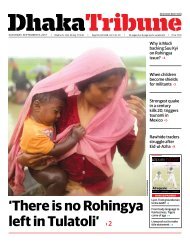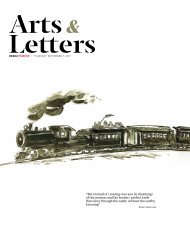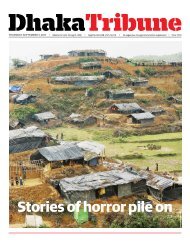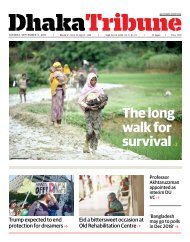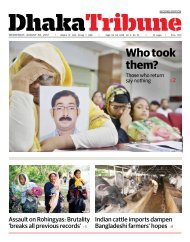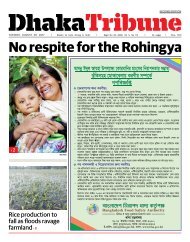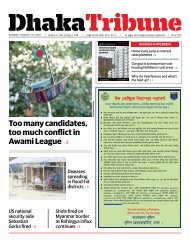DT e-Paper, Friday, Decdember 2, 2016
You also want an ePaper? Increase the reach of your titles
YUMPU automatically turns print PDFs into web optimized ePapers that Google loves.
Opinion 21<br />
<strong>DT</strong><br />
FRIDAY, DECEMBER 2, <strong>2016</strong><br />
A brief history of grievances in the CHT<br />
Is peace in sight for the Pahari population of Bangladesh?<br />
LETTER<br />
FROM<br />
AMERICA<br />
• Fakhruddin Ahmed<br />
Since today is the 19th<br />
anniversary of the signing<br />
of the Chittagong Hill<br />
Tracts Peace Accord, a brief<br />
review of the recent history of the<br />
indigenous people is in order.<br />
Mir Qasim Ali Khan, the British<br />
East India Company-installed<br />
governor of Bengal after the ouster<br />
of Mir Jafar Ali Khan, gifted the<br />
The government must recognise indigenous land rights<br />
To date, only a few<br />
provisions of the<br />
Peace Accord have<br />
been implemented<br />
Chittagong Hill Tracts (CHT) to the<br />
Company in the 1760s. In 1860, the<br />
British designated CHT a district<br />
of Bengal.<br />
The Company demanded that<br />
the indigenous people pay taxes in<br />
the form of karpas or raw cotton,<br />
which were collected by Bengali<br />
agents, beginning the Bengali<br />
migration to the predominantly<br />
Pahari CHT. The Bengali migrants<br />
were government agents, traders,<br />
and money-lenders.<br />
The Company switched to<br />
cash taxation in 1789, forcing the<br />
monetisation of the centuriesold<br />
subsistence-oriented, Pahari<br />
Jhum economy. Jhum cultivation<br />
involved clearing the thicket of<br />
the hillside through fire, which<br />
yielded fresh soil, with the<br />
cinders acting as fertiliser. Seeds<br />
of different crops were mixed<br />
and sown in this soil. Rice and<br />
vegetables were harvested within<br />
months; cotton, turmeric, etc<br />
several months later; and wood<br />
years later. After the land lost its<br />
fertility, it was left fallow for 15-20<br />
years, and the process is repeated<br />
on different slopes.<br />
The British opposed Jhum<br />
cultivation because it yielded<br />
low revenue, and it was harder<br />
to impose political control over<br />
a people continually shifting<br />
their cultivation lands. They<br />
introduced plough cultivation<br />
in the 1850s, which created a<br />
demand for Bengali cultivators<br />
from the plains who possessed the<br />
requisite knowhow. The Chakma<br />
elite employed Bengali sharecroppers<br />
to plough their paddy<br />
lands in the flat valleys of the<br />
CHT. The introduction of wet-rice<br />
cultivation resulted in the influx<br />
of Bengali craftsmen, artisans, and<br />
traders.<br />
The valley-dwelling and<br />
plough-cultivating Chakma,<br />
Marma, and Tripura became<br />
relatively prosperous and<br />
politically dominant. They were<br />
less resistant to cultural intrusion<br />
from the plains than the ridge-top,<br />
Jhum-cultivating Mru, Bawm,<br />
Pankhua, and Khumi.<br />
Disregarding the indigenous<br />
people’s historical rights to the<br />
lands, in 1875, the British created<br />
two categories of land: The<br />
Reserve Forests (RF), and the<br />
District Forests, now known as<br />
Unclassed State Forests (USF).<br />
By 1882-83, nearly a quarter of<br />
the total area of the CHT was<br />
“enclosed” as Reserve Forests,<br />
transforming the lands of the<br />
CHT into different categories of<br />
property.<br />
In 1881, the government of<br />
Bengal restructured authority<br />
among the Hill peoples, based on<br />
three “chiefs” among their society.<br />
Most of the CHT was divided into<br />
three “circles,” each placed under<br />
a chief: The Mong Circle under its<br />
chief in Manikchhari, the Chakma<br />
Circle under its chief in Rangamati,<br />
and the Bohmong Circle under its<br />
chief in Bandarban.<br />
The Chittagong Hill Tracts<br />
Regulation of 1900 provided the<br />
legal framework for civil, revenue,<br />
and judicial administration in<br />
CHT. The regulation vested the<br />
deputy commissioner (DC) with all<br />
executive, judicial, and financial<br />
powers, with absolute power over<br />
land rights and settlements. It<br />
reaffirmed the traditional structure<br />
based on the three circles, while<br />
redefining the relationship<br />
between the chiefs and the district<br />
administration under the DC.<br />
Pakistan kept the CHT<br />
Regulation of 1900, and Pakistan’s<br />
1956 constitution preserved CHT’s<br />
status as an “excluded area.”<br />
The Pakistani government was<br />
primarily interested in exploiting<br />
the rich natural resources of the<br />
CHT. Karnaphuli <strong>Paper</strong> Mill in<br />
Chandraghona (1953), which<br />
utilised bamboo and softwood<br />
from local forests, was the first<br />
developmental intervention. The<br />
Karnaphuli Multipurpose Project<br />
(“Kaptai Project” of 1957-63),<br />
that generated hydro-electricity<br />
by damming Karnaphuli river at<br />
Kaptai, was the second.<br />
The Kaptai Lake inundated<br />
the valleys of Karnaphuli River<br />
and its tributaries, including the<br />
Chengi, Kassalong, and Maini<br />
valleys. About 400 square miles<br />
were submerged, including “Old”<br />
Rangamati town, the main urban<br />
centre of CHT. Catastrophically,<br />
54,000 acres of the highly-prized<br />
plough lands were submerged,<br />
amounting to 40% of plough<br />
lands. Many Paharis were<br />
uprooted, and became internally<br />
displaced. The Kaptai project<br />
saw further influx of Bengali<br />
and non-Bengali Pakistanis who<br />
monopolised trade, commerce,<br />
and government jobs, fueling<br />
Pahari resentment.<br />
In the conflict between Bengali-<br />
Pakistani nationalisms in 1971,<br />
most indigenous people remained<br />
noncommittal. While the Chakma<br />
and Bohmong chiefs gave support<br />
to Pakistan, the Mong chief, and<br />
some Chakma and Marma leaders<br />
attempted to join Mukti Bahnini,<br />
only to be rebuffed.<br />
Limited collaboration with<br />
the Pakistani Army by some of<br />
them resulted in the erroneous<br />
notion that all indigenous peoples<br />
opposed Bangladesh’s liberation,<br />
which they did not, and for which<br />
they suffered deadly retribution.<br />
Leading an indigenous<br />
delegation, Manabendra Narayan<br />
Larma met then Prime Minister<br />
Sheikh Mujibur Rahman with a<br />
four-point demand on February 15,<br />
1972: (1) Autonomy for CHT along<br />
with the establishment of a special<br />
legislative body for the region. (2)<br />
Retention and endorsement of<br />
the CHT Regulation of 1900 in the<br />
new constitution of Bangladesh.<br />
(3) Continuation of the offices of<br />
the tribal chiefs. (4) Constitutional<br />
provisions restricting further<br />
amendment of the CHT<br />
Regulation, and imposing a ban on<br />
further Bengali settlement in the<br />
CHT.<br />
Bangladesh’s Constitution<br />
(November 4, 1972) ignored<br />
their aspirations. Abandoned<br />
by their own government, they<br />
formed the Parbatya Chattagram<br />
Jana Samhati Samity (PCJSS) to<br />
protect their interests. In response<br />
to the government’s gradual<br />
militarisation of CHT (1972-75),<br />
the PCJSS’s military wing, “Shanti<br />
Bahini,” (SB) was born.<br />
Believing that foreign powers<br />
were fomenting unrest, and had<br />
designs for the natural resourcerich<br />
CHT, General Ziaur Rahman’s<br />
regime banned PCJSS, sending the<br />
movement underground to India,<br />
and triggering SB insurgency in<br />
1976. A component of the counterinsurgency<br />
strategy was to evict<br />
and relocate them from their land,<br />
and settle Bengalis there.<br />
While the SB primarily targeted<br />
Bengali settlers, the security forces<br />
burned villages, tortured, and<br />
killed men, and raped women in<br />
retaliation, they allege.<br />
Unable to quell the insurgency,<br />
in October 1983, General Ershad’s<br />
regime announced its willingness<br />
to suspend further migration of<br />
Bengalis to CHT, start dialogue<br />
with the PCJSS leadership, and<br />
grant amnesty to rebels.<br />
It also initiated a generally<br />
successful policy of government<br />
largesse to “pacify” the indigenous<br />
population. The CHT Peace Accord<br />
was signed on December 2, 1997 by<br />
the AL government.<br />
In exchange for general<br />
amnesty, repatriation, and<br />
rehabilitation, the PCJSS/SB<br />
members surrendered and<br />
disarmed. The government agreed<br />
to mechanisms for recognising<br />
and recording of indigenous land<br />
rights, cancellation of illegal leases<br />
and settlements, setting up of<br />
a Land Commission, a Ministry<br />
of CHT Affairs to be headed by<br />
an indigenous minister, and<br />
a regional council (RC) with<br />
jurisdiction over the entire CHT.<br />
To date, only a few provisions<br />
of the Peace Accord have been<br />
implemented.<br />
Current estimates put CHT’s<br />
generally Theravada Buddhismpracticing<br />
Pahari population<br />
at over 50%. From less than<br />
2% during the British period,<br />
the Bengali, mostly Muslim,<br />
population has skyrocketed to<br />
49%. Although the demographic<br />
dynamics of two-and-a-half<br />
centuries cannot be reversed<br />
overnight, indigenous grievances<br />
can be partially assuaged if the<br />
ecological disaster, Kaptai Dam, is<br />
dismantled.<br />
That would resurface 4,000<br />
square miles of land, which should<br />
be restored to the indigenous<br />
Bangladeshis of CHT for their<br />
exclusive use. •<br />
Dr Fakhruddin Ahmed is a Rhodes<br />
Scholar.




